
Olearia axillaris, commonly known as coastal daisy-bush, coast daisy-bush or coastal daisybush is a species of flowering plant in the family Asteraceae and is endemic to coastal areas of Australia. It is an erect, bushy shrub with densely cottony-hairy branchlets, aromatic, linear to narrowly elliptic or narrowly lance-shaped to egg-shaped leaves with the narrower end towards the base and small white and yellow, daisy-like inflorescences.
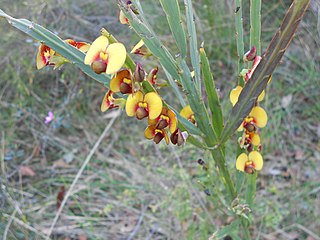
Bossiaea ensata, commonly known as sword bossiaea, is a species of flowering plant in the family Fabaceae and is endemic to south-eastern continental Australia. It is an erect or low-lying, glabrous shrub with flattened branches, flattened, winged cladodes, leaves mostly reduced to small scales, and orange-yellow and red flowers.

Leptospermum myrtifolium, commonly known as the myrtle tea-tree or grey tea-tree, is a species of shrub that is endemic to south eastern Australia. It has broad egg-shaped to elliptical leaves, white flowers usually borne singly on short side shoots, and fruit that remains on the plant until it dies.
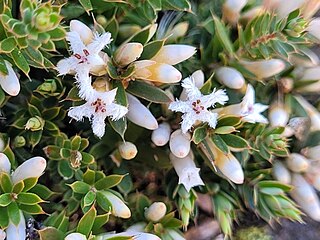
Styphelia nesophila, commonly known as sharp beard-heath, is a species of flowering plant in the heath family Ericaceae and is native to south-eastern Australia and New Zealand, where it is known as pātōtara, or dwarf mingimingi. It is a prickly, prostrate to trailing or low-growing shrub with egg-shaped leaves, and erect, tube-shaped white flowers usually arranged singly in leaf axils.
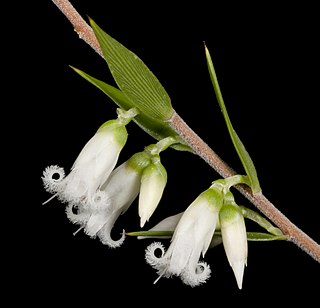
Styphelia conostephioides is a flowering plant in the family Ericaceae and is endemic to the south-west of Western Australia. It is an erect, straggling shrub with lance-shaped leaves with a sharp point on the tip, and white flowers arranged in pairs in leaf axils.
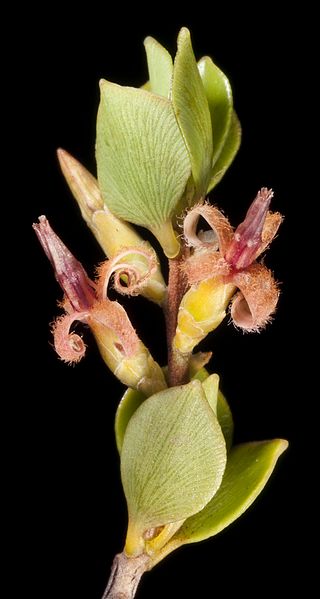
Styphelia coelophylla is a plant in the family Ericaceae endemic to the south west of Western Australia. It is an erect, bushy shrub with egg-shaped to lance-shaped leaves and tube-shaped flowers.

Pultenaea euchila, commonly known as orange pultenaea, is a species of flowering plant in the family Fabaceae and is endemic to eastern Australia. It is an erect shrub with glabrous foliage, narrow egg-shaped leaves with the narrower end towards the base, and orange-coloured flowers arranged singly or in small groups near the ends of branchlets.
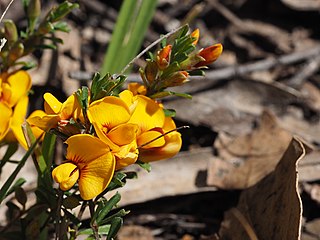
Pultenaea microphylla is a species of flowering plant in the family Fabaceae and is endemic to eastern Australia. It is an erect to prostrate shrub with narrow egg-shaped leaves with the narrower end towards the base, and clusters of up to ten yellow to red flowers with reddish markings.

Pultenaea parviflora, commonly known as Sydney bush-pea, is a species of flowering plant in the family Fabaceae and is endemic to eastern New South Wales. It is usually a small, erect shrub with wedge-shaped to narrow egg-shaped leaves with the narrower end towards the base, and clusters of yellow to orange and red flowers.

Epacris coriacea is a species of flowering plant in the heath family Ericaceae and is endemic to a eastern New South Wales. It is a slender, erect shrub with hairy branchlets, egg-shaped to more or less diamond-shaped leaves and tube-shaped, white or cream-coloured flowers.

Sprengelia monticola, commonly known as rock sprengelia, is a species of flowering plant of the family Ericaceae, and is endemic to the Blue Mountains in eastern New South Wales. It is an open or low-lying shrub with egg-shaped to lance-shaped leaves, and white flowers arranged singly in leaf axils.

Sprengelia propinqua is a species of flowering plant of the family Ericaceae, and is endemic to Tasmania. It is an erect, robust shrub with overlapping, stem-clasping, egg-shaped leaves, and white flowers crowded in upper leaf axils.

Leucopogon capitellatus is a species of flowering plant in the heath family Ericaceae and is endemic to the south-west of Western Australia. It is an erect, more or less glabrous shrub that typically grows to a height of 0.2–1 m. It has linear to lance-shaped leaves longer than about 12 mm (0.47 in) long, tapering to a rigid point on the tip. The flowers are borne on short spikes on the ends of branches or in leaf axils on short side branches, with small bracts and bracteoles about half as long as the sepals. The sepals are broad, about 2 mm (0.079 in) long and the petals white and about 4 mm (0.16 in) long, the petal lobes longer than the petal tube.

Olearia ramosissima, commonly known as much-branched daisy bush, is a species of flowering plant in the family Asteraceae and is endemic to continental Australia. It is a straggly shrub with densely-crowded, elliptic, egg-shaped or triangular leaves, and blue to violet and blue or yellow, daisy-like inflorescences.
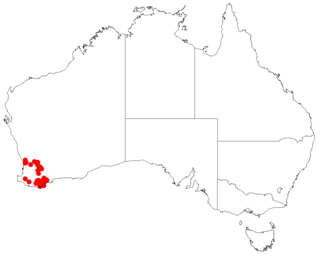
Styphelia cymbiformis is a flowering plant in the family Ericaceae and is endemic to the south-west of Western Australia. It is a bushy or wiry shrub that typically grows to a height of 30–50 cm (12–20 in) and has more or less glabrous branches. Its leaves are erect, linear to lance-shaped and sharply-pointed, mostly 2–4 mm (0.079–0.157 in) long. The flowers are arranged in short spikes, sometimes of only two or three flowers, with lance-shaped, leaf-like bracts, and bracteoles half as long as the sepals at the base of the spikes. The sepals are 2.5–3.0 mm (0.098–0.118 in) long and the petals slightly longer than the sepals, the lobes shorter than the petal tube.

Styphelia insularis is a species of flowering plant in the heath family Ericaceae and is endemic to the south-west of Western Australia. It is a rigid, scrubby shrub with many branches, linear or oblong leaves and tube-shaped, white flowers.

Pimelea umbratica, is a species of flowering plant in the family Thymelaeaceae and is endemic to eastern Australia. It is a shrub with densely hairy young stems, narrowly elliptic or more or less oblong leaves, and white flowers arranged singly, or in small groups, in leaf axils.

Leucopogon racemulosus is a species of flowering plant in the heath family Ericaceae and is endemic to the south-west of Western Australia. It is an erect, rigid shrub with linear leaves and white, tube-shaped flowers usually arranged in pairs or threes in leaf axils.

Styphelia angustifolia is a species of flowering plant in the heath family Ericaceae and is endemic to eastern New South Wales. It is an erect shrub with lance-shaped to narrowly egg-shaped leaves and pale green, pendent flowers in summer.
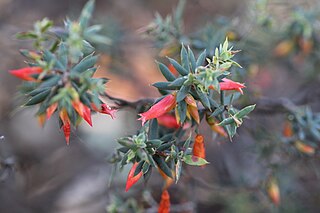
Styphelia epacridis is a flowering plant in the family Ericaceae and is endemic to the south-west of Western Australia. It is a straggling shrub with lance-shaped or linear leaves with a sharp point on the tip, and red, tube-shaped flowers arranged singly in leaf axils.




















